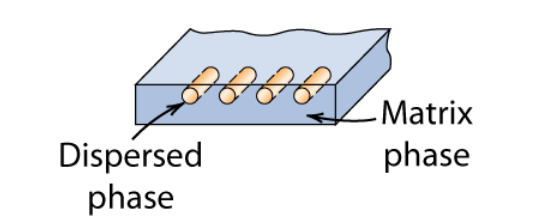Composite materials are materials which are a combination of two or more distinct individual materials. These combinations are formed to obtain a more desirable combination of properties. This is called the principle of combined action. One example of this principle is the use of composites for aircraft structures. These composites are designed to be lighter weight with comparable strength to metal structural elements that they are replacing. Typically, a composite is formed with a continuous phase called the matrix. As shown in the figure below, the matrix phase surrounds another phase which is discontinuous and referred to as the dispersed phase.

The purpose of the matrix phase is to keep the dispersive phase in place, transfer stress to the dispersed phase, and protect the dispersed phase from the environment. The purpose of the dispersed phase typically depends on which material type it is composed of:
- Metal dispersive phases are typically used to increase yield strength, tensile strength, and/or provide stability over the life of the product.
- Ceramic dispersive phases are typically used to produce materials which resist fracture.
- Polymer dispersive phases are typically used to increase the modulus of elasticity, yield strength, tensile strength, and/or provide stability over the life of the product.
Composites are typically classified by the type of dispersive phase used: particle reinforced, fiber reinforced, or structural. Further details on these different types of dispersive phase types will be forthcoming in the reading for this lesson, but first please watch this short four-minute video introducing composites. Note that in this video what we are calling the dispersive phase they refer to as the reinforcement phase.
To Watch
From huts of mud and grasses to monuments of stone and steel. The rise of modern civilization has been paced by our development of new materials. We began with Earth, wood, and rocks. We built shelters and tools. We harnessed fire and learned to coax metal from stone. And then one day a brickmaker added straw to his clay the result was a stronger brick and the birth of manmade composites.
So what is a composite, really? Simply it's two different materials combined. The uniform substance like portland cement is called a monolithic material. Throw in a handful of gravel another monolithic material and you have concrete. A composite. In a composite you can still see the individual monolithic materials the cement in the gravel they're just locked together.
So why make composites? We combine two similar materials to create a new material that has the characteristics we need for a particular application. Portland cement is pretty tough, but you wouldn't build a bridge out of it. It's not strong enough or durable enough. Throw in some gravel and now it's durable enough for traffic, but still not strong enough to span supports. Drop in a nice grid of steel rebar and now you've got a composite material that's strong enough for bridge decking. In addition to increased strength and durability, composites also allow us to customize materials with the weight flexibility conductivity and stability we need. Although composites can have several different components they all have two things in common a matrix and reinforcement.
In our concrete bridge, the cement is the matrix and the gravel and rebar are both reinforcements. Many modern composites use resins as a matrix. Add wood or wood fibers and you have a broad family of products from plywood and particle board to high-density fiberboard and composite decking panels. Adding glass fiber or fabric as reinforcement creates fiberglass widely used everything from auto body parts and both holes to tennis rackets and swimming pool liners. Many of the most recent advances in composites have been in the field of aerospace where highly specialized fibers such as graphite or on and Kevlar are used to create incredibly strong yet amazingly lightweight materials.
Composites, they're everywhere. Building materials, furniture, toys, sports, equipment, the games we play, the roads we walk, the cars we drive, the planes we fly. Composites - they make so much of what we do every day possible.
Now that you have watched this video, please proceed to the next section.